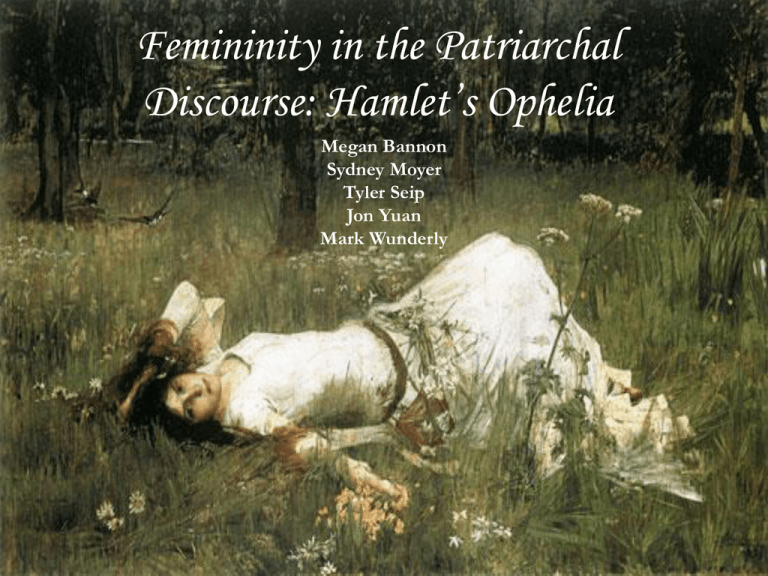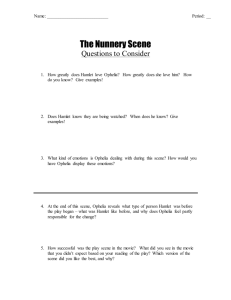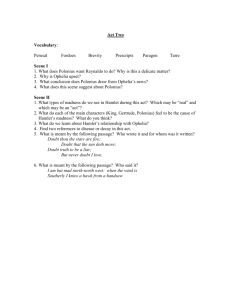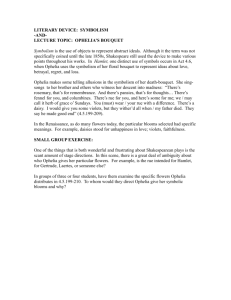
Femininity in the Patriarchal
Discourse: Hamlet’s Ophelia
Megan Bannon
Sydney Moyer
Tyler Seip
Jon Yuan
Mark Wunderly
Women in England during Shakespeare’s Time
• Had very limited rights: they were denied
formal education and the chance to hold public
office or other professions such as law, medicine,
etc.
• Childbearing was considered a great honor
• Considered a threat to the public.
• Common belief that women always needed
someone to look after them
• No woman could vote.
• Although denied a formal education,
many women of this time period were highly
educated due to the use of private tutors.
• Single women often accused of being
witches/looked upon with suspicion
• An unmarried women could inherit property and
sign contracts.
• Women were encouraged to write literature, mainly
religious works.
Double Standards
•Hamlet ‘s past can be read through his father, his education, and his
relationship with his friends
•Recent feminist critics see the lack of Ophelia’s past
as representative of a double standard
•“We can imagine Hamlet’s story without
Ophelia, but Ophelia literally has no story
without Hamlet.”
•In Act 1 Scene 3, Polonius sends Laertes off urging
him to use his judgment and learn through error
•But he does not put that trust in Ophelia’s conviction
of Hamlet’s love
Polonius to Ophelia:
“Affection, puh! You speak like a green
girl…think yourself a baby That you have ta’en these
tenders for true pay, which are not sterling…”
•Ophelia was never given the chance to develop an independent conscience
•“…stifled is she by the authority of the male world.”
Femininity Through Insanity
• “Whereas madness for Hamlet is
metaphysical, linked with culture, for Ophelia
it is a product of the female body and female
nature, perhaps that nature’s purest form.”
• Ophelia dresses in white, decks herself with
“fantastical garlands” of wild flowers and
enters “distracted,” playing a lute, with her
hair down, singing.
• Femininity is displayed through apparent
absent-mindedness
Femininity Through Insanity
• Speech marked by extravagant
metaphors, lyrical free associations and
“explosive sexual imagery.”
• Ophelia: “You sing ‘A-down a-down’– and
you ‘Call him a down-a.’ O, how the wheel
becomes it! It is the false steward that stole his
master’s daughter.”
• Laertes: “This nothing’s more than matter.”
(217)
• Laertes is saying that this nonsense
speaks more eloquently than serious
speech
– Feminine = eloquent, yet
incoherent.
Femininity Through Insanity
• “Optimistically, Ophelia’s madness offers
the capability of speech, the opportunity
to discover individual identity, and the
power to verbally undermine authority. A
thorough analysis of Ophelia’s mad
ramblings (and their mutual levels of
meaning) provides “a singular exposé of
society, of the turbulent reality beneath its
surface veneer of calm” (418); but her
words still suggest a fragmented self and
provide others the opportunity to
manipulate meanings that best suit them.”
Femininity Through Insanity
• Ophelia initially appears “shaped to
conform to external demands, to
reflect others desires” (406): she
is Laertes’ “angel,” Polonius’
“commodity” (407), and Hamlet’s
“spectre of his psychic fears”
(410). While the conflicting
messages from these
male/masculine sources damage
Ophelia’s psychological identity,
their sudden absence provokes her
mental destruction.
• Ophelia is objectified by the other
characters in the play, becomes a
more of a possession than a
character.
• Therefore, mental deterioration is
equated with individual identity in a
• “The division of space between Ophelia and the natural details Millais had so
painstakingly pursued reduces her to one more visual object; and the painting
had such a hard surface, strangely flattened perspective, and brilliant light that
it seems cruelly indifferent to the woman’s death.”
Femininity Through Fluidity
• As we all know, Ophelia kills herself
by drowning
– Link between Ophelia’s death
and the death of Katherine
Hamlet
– Accidental - Act 4. Sc. 7,
“Clamb’ring to hang, an envious
sliver broke, When down her
weedy trophies and herself fell in
the weeping brook.”
– Merely an afterthought, “One
woe doth thread upon another’s
heel, So fast they follow. Your
sister’s drowned, Laertes.”
– Conscious - Act 5. Sc. 1, “If I
drown myself wittingly…”
Femininity Through Fluidity
• Water is the ultimate material
associated with cleansing.
– Purification, ablution, baptism
in Christianity
– Generally, a body is washed and
dressed before burial - it’s an
important aspect of charitable
care for the departed. By
means of drowning, Ophelia is
seemingly neglected by the
family, washes herself).
– Sexual, emotional cleansing
Femininity Through Fluidity
• Feminine fluidity contrasts
masculine aridity.
– Elements of water associated
with the woman: tears, blood,
milk.
– Water - an essential element of
life
– Laertes contrasts Ophelia’s
response to Polonius’ death;
Ophelia drowns, Laertes fights.
Act 4. Sc. 7 “Too much of
water hast though, poor
Ophelia, And therefore I forbid
my tears.” Act 4. Sc. 5 “I cannot
choose but weep to think they
would lay him I’ th’ cold
ground.”
Femininity Through Fluidity
• Drowning is considered a
very feminine way of dying.
– “One which is a
beautiful immersion and
submersion in the female
element.”
• Act 4. Sc. 7 “And one
incapable of her own
distress Or like a
creature native and
endued Unto that
element.”
Femininity Through Fluidity
• Ophelia differs from other famous women of the water (Venus rises
from the sea at her birth, Ophelia ends and stays in the sea)
• Never receives a dignified death; by drowning, her ashes won’t mix with
those noble men; being a woman, she is insignificant. Even when she is
to be properly buried, Act. 5, Sc. 1, “Is she to be buried in Christian
burial, when she willfully seeks her own salvation
“Symbolic Deflowering”
• Elizabethans would have recognized the flowers
that Ophelia clutched to when she drowned as phallic
symbols, indicative of her repressed longings
• Feminine madness with the adornment of wild
flowers portrayed “symbolic deflowering”
Rosemary- was given as a token of remembrance
between lovers
Pansies- represented erotic thoughts
Fennel- symbolized not only flattery but also
fickleness in love and even women’s sexual
desire
Columbine- symbol of adultery
“Symbolic Deflowering”
Rue- sorrow/repentance but was even
thought to
abate carnal lust
Daisy- self sacrifice for
love/dissembling love
•These garlands that she drowns in
represent the conflicting feelings (innocence,
pain, and sexuality) that caused her to need an
escape from her oppressive lifestyle
•The flowers suggest a contradiction of
female sexuality as both “innocent blossoming
and whorish contamination.”
Madness as Sexual Excess
•Honor and virginity were the basis for a woman’s
value in a patriarchal society
•Many feminist critics have suggested that Ophelia's
madness is directly related to her sexual nature.
•Men went mad for reasons like mental or physical
stress
•Women’s madness was associated with their bodies
and erotic desires
•Doctors believed that the cause of hysteria in
women was lack of sex/social helplessness
•So some critics reason that Ophelia’s death was
caused by Polonius who prevented her from
marrying Hamlet
•She was then unable to fulfill her natural role as
wife/sexual being and her suicide was “imminent.”
A Creature of Lack
• Act 3, Scene 2- When Hamlet twists
Ophelia’s words/degrades her with a sexual innuendo
Ophelia: “I think nothing, my lord”
Hamlet: “That’s a fair thought to lie between a maid’s legs.”
Ophelia: “What is, my lord?”
Hamlet: “Nothing.”
Ophelia: “You are merry, my lord.”
• Act 4, Scene 5- Ophelia’s gone mad and
the Gentleman insists her speech doesn’t matter
Gentleman: “Her speech is nothing /Yet the unshaped
Use of it doth move the hearers to collection.”
• Ophelia’s thoughts mean nothing in the
public terms defined by the court
• She’s deprived of thought, sexuality, and language
• When she drowns, Ophelia wears virginal white (lack
of color) which contrasts with Hamlet’s “suits of solemn black.”
• Critics refer to her story as the Story of Zero or “mystery of feminine
difference”







